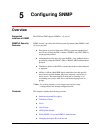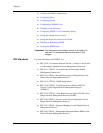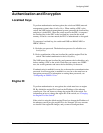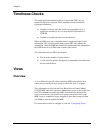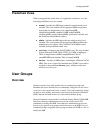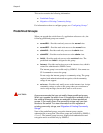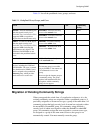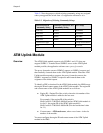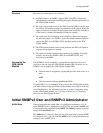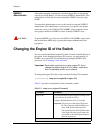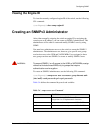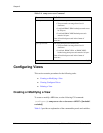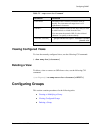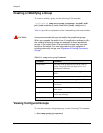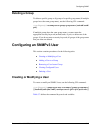
5-8 User Guide for the Avaya P580 and P882 Multiservice Switches, v6.1
Chapter 5
Table 5-2 lists the groups to which existing community strings are assigned
when you upgrade the switch from v5.x application software to v6.x.
ATM Uplink Module
Overview The ATM Uplink module supports only SNMPv1 and v2. It does not
support SNMPv3. To make secure SNMPv3 access to the ATM Uplink
module possible, the application software uses a proxy forwarder.
The proxy forwarder converts SNMPv3 requests to SNMPv1 requests and
then internally forwards them to the ATM Uplink module. When the ATM
Uplink module responds to requests, the proxy forwarder converts the
SNMPv1 responses to SNMPv3 responses and forwards them to the
originator of the initial request.
To identify a PDU as destined for the ATM Uplink module, the NMS inserts
the engine ID and context name of the ATM Uplink module. The engine ID
and context name of the ATM Uplink modules are as follows:
■ Engine ID—Engine ID of the switch, where the slot number of the
ATM Uplink module is added to the last octet.
For example, if the engine ID of the switch is
00:00:1a:e9:01:7f:00:00:01:00:00:00 and an ATM Uplink module is
in slot 11, the engine ID of the ATM Uplink module is
00:00:1a:e9:01:7f:00:00:01:00:00:0B. (B is the hexidecimal value
for 11.)
■ Context name—ATM<mod-num>, where <mod-num> is the slot
number of the module.
You must configure the engine ID and context name of the ATM Uplink
module in the NMS.
Table 5-2. Migration of Existing Community Strings
Access of Pre-6.0
Community String
Security Level of Pre- 6.0
Community String
6.x Group
Read-only Normal normalRO
Read-write Normal normalRW
Read-only Admin adminRO
Read-write Admin adminRW
Custom access type Group of same name
None noAccess




